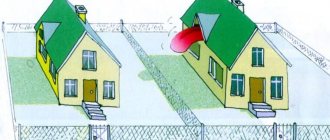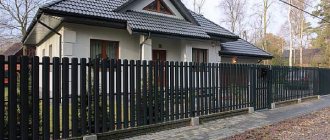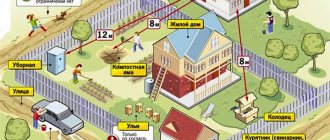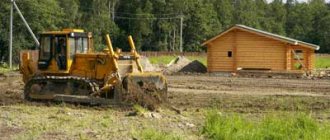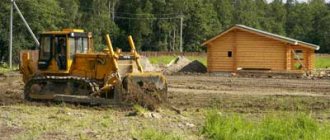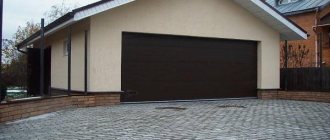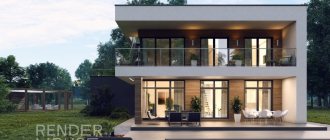Owners of private houses are faced with the need to complete and rebuild outbuildings according to their needs. The main condition for the further trouble-free operation of such buildings will be the regulatory regulation of the location in accordance with construction rules. To find out all the nuances associated with planning and building a garage extension, our article has selected answers to many thematic questions. So let's answer the question at what distance from the fence you can build a garage.
Site planning
Of course, the owners of new buildings were extremely lucky, because construction, as a rule, was carried out taking into account all existing standards. If there are already buildings on your site, and now the question of moving or building new ones has arisen, it is imperative to study the legislative framework regarding the distances between buildings.
General provisions for placing objects on a land plot:
- The distance from the residential building to the fence should be 3 meters or more. If there is a utility room attached to the house, it is necessary to count from it. The minimum distance between residential buildings is six meters.
- When constructing outbuildings, it is necessary to retreat at least a meter from the nearest fence. If the roof slope has a wide span, it is necessary to calculate the distance from it. If these conditions are not met, the neighbor can file a lawsuit and force the building to be demolished or rebuilt.
- The minimum distance between adjacent buildings must be at least six meters. By mutual agreement of neighbors, this parameter can be reduced, but problems may arise with architectural institutions and further paperwork.
- Buildings intended for keeping domestic animals must be located at least four meters from the fence. The optimal distance to a residential building will be 15 meters, but in reality this parameter is very difficult to maintain due to limited space.
- Sanitary facilities, such as toilets, showers and baths, are considered potentially dangerous sources of groundwater contamination. Their location should be no closer than 2.5 - 3 meters from the neighboring fence. This rule can also be applied to silo pits, but it will be difficult to prove anything in case of claims; it is better to resolve such nuances amicably.
- Gazebos must be located at a distance of three meters from the main building. If we are talking about a temporary summer version of a collapsible structure, it can be placed at a meter distance from the fence and buildings. If the gazebo is also equipped with a fireplace or barbecue, the distance from the residential building must be at least ten meters.
- Summer kitchens and greenhouse structures must also be located at least a meter from any buildings. These requirements will help not only comply with regulations, but also make further operation comfortable.
- Perennial plantings should also not be located chaotically. Regulated standards for shrubs require a distance of at least a meter from the neighboring fence. For short trees this is two meters, and tall plantings must be planted at a distance of at least four. A growing crown will not reduce this figure, since the calculation is carried out from the center of the trunk.
Of course, minor deviations from these standards are possible. As a rule, such issues are resolved with mutual consent of the owners of neighboring plots. Do not forget about fire safety, for example, it is necessary to maintain the specified distance between houses. In the event of a fire, there is a high risk of the fire spreading to neighboring buildings, so this is a very sensitive issue. Some aspects of the location of the garage building are discussed below.
When is permission not needed?
If you plan to build on your own residential plot, you will not need to obtain permission for a garage.
According to the town planning code, there is no such need in two cases:
- construction is supposed to be on a land plot provided to an individual not for conducting business or gardening activities;
- There are plans to build auxiliary structures on the site.
Permission from construction supervision.
Also, permission will not be required for the construction of non-permanent premises, that is, without a foundation, which, theoretically, can be easily moved.
Despite this, everything is not so simple. Construction must be carried out in accordance with certain requirements, they will be detailed below in the article.
In addition, the presence of an unregistered building on its territory will create problems when selling, and violation of the rules may lead to complaints from neighbors, as a result of which the premises will be recognized as an unauthorized construction, and the court will decide to demolish it at the personal expense of the owner, and this is in no case allowed admit.
It should be taken into account that in a situation with a full-fledged construction on individual housing construction or private plots, registration will be required, since, like a house, it will be taxed. First, you need to obtain a certificate of ownership of the land, then legalize the garage premises itself by contacting Rosreestr with a package of documents.
Detached garage
The most popular and traditional option is that the garage is separate from the residential building. It can combine additional functions: a basement, a workshop or utility rooms for storing tools. If this is your case, do not ignore some important aspects of placement on the site.
Basic moments:
- To erect a building, it is advisable to use the northern side, an unused plot, or simply a plot of land that is optimal in location.
- When combining a garage with other outbuildings, it is necessary to consider two separate entrances that do not communicate with each other. To do everything in accordance with the letter of the law, the distance between entrances must be at least seven meters.
- To build a garage, you must choose a site on an elevation (natural or specially created). This will protect the building from flooding and help make a suitable entrance.
- Melt water should only be drained onto your own site. If the canopy of a building exceeds half a meter, the distance to the adjacent fence is measured from its projection.
- If there is already any structure on the neighbor’s property, the location of the garage must be at least five meters away from it. How you can reduce this distance is described a little further.
Is it possible to build a garage on the boundary line? This issue is discussed in detail in further information. If we are talking about a permanent structure, be sure to make such changes to the official site plan. This will save you from many bureaucratic problems in the future and will allow you to feel confident in any situation. You should also not ignore maintaining the required meter between the fence and the building. Even without taking into account possible problems with neighbors, this distance will help in the trouble-free operation and maintenance of the building, for example, when performing external insulation or painting.
Reference points
The starting point is the base or wall of the house. In this case, the length of all protruding parts of the structure should not exceed half a meter.
The garage must be equipped with an access road leading to the housing. It is not prohibited for it to be adjacent to other commercial buildings.
In no case should you neglect the provisions of SNiP, even if you live alone, fenced off from the world by a high fence. There is a high probability of problems if you decide to make any transactions with the land and house in the future.
Moreover, not a single restriction exists without a reason, and building standards are dictated primarily by considerations of citizen safety.
Garage in the architecture of a residential building
This option is typical for European and American residential buildings. At the same time, it is very convenient and practical, which is why new buildings, even multi-story ones, are often designed this way. The basement or “zero” floor is allocated for the garage space, and the entrance is located on the side of the facade where there is no central entrance. This arrangement has its advantages and disadvantages, but it is important to think through other important details.
Important nuances of the built-in garage option:
- The room should not be connected to living rooms. The option when purchases are unloaded directly into the kitchen is very tempting, but has a number of disadvantages, for example, exhaust gases entering the living space.
- It is advisable not to plan a bedroom or nursery above the garage. This is difficult to do, because we try to make maximum use of all the usable space. At the same time, these are fire safety requirements, so compliance with them will not be superfluous.
- Supply and exhaust ventilation is a must! In this case, it is best not to rely on natural air circulation, but to install a small fan-type device at the ends of the ventilation pipes. This will significantly improve the quality of ventilation, and also make this “neighborhood” with the living space safe and comfortable.
- The entrance to the garage must be located at least a meter from the fence. It would be useful to repeat the rules for the location of the garage in relation to the “red” line, which are described below.
Before planning, it is imperative to check the groundwater level. This is done with special equipment at the stage of project creation, so additional modernization of an existing building requires extreme caution.
Attached garage space
In general, here you can also focus on the previous option. The entrance must be thought out so that the car does not turn anywhere, much less go around the house. In addition to rational use of space, this option is as safe as possible for loved ones and convenient for everyday use. The code does not specify the height of a structure, but complaints from neighbors about shading may result in litigation and scrutiny of other possible construction violations. That is why when planning it is necessary to take into account this important nuance.
Placing a garage on the “red” line
This term did not arise by chance; it is a kind of access zone to important communications: electrical wires, sewer pipes and water supply. This is a necessary condition for the normal functioning and operation of systems. Placing any objects on it can be regarded as a threat in case of emergency situations. The same rule applies to a car parked on the street, even temporarily. To avoid problems in the future, it is better to think about the issue of comfortable and safe entry into your territory.
If you pay attention, many car owners plan the location of the garage entrance directly from the street. This is very convenient and saves a lot of time and effort; in addition, on a busy street there may simply not be enough time to open and close the entrance gate to the territory, creating a traffic jam of other cars. The best option would also be to install a small ramp for entry and roller automatic garage doors. The described option is quite good, but if there are any communications directly outside your fence, the realization of this dream threatens serious troubles and financial costs.
The thing is that according to the law, it is necessary to retreat at least five meters from the red line. Such conditions are also often impracticable because a distance of at least three meters is also provided from the garage to the residential building. A little trick can save you: the entrance to the garage can be located at a meter distance from the fence border. Simple architectural tricks and the ability to create an individual parking zone will be a pleasant bonus. In the event of litigation, you can always point to that clause of the rules that requires the garage to be located at a meter distance from the fences. In this case, a canopy or additional canopy is not considered a reference point if this structure does not protrude beyond the boundaries of your own site.
An important point: red lines can be not only existing in reality, but also planned, for example, during gasification of this section. This will create certain difficulties with the construction of any buildings, so it is better to comply with the specified standards, even just “just in case.”
Construction documents
The flexible system of legislation does not regulate exactly what must be provided before building your own garage. The best option is to find an intelligent architect associated with this field. Regulations may change even depending on the region of residence, so it is impossible to provide exact advice and instructions.
The following points can be highlighted:
- The construction of a garage on the site of an old structure already included in the technical passport does not require registration again.
- Modernization and any design changes must be agreed upon and also secured at the legislative level.
- The construction of a new residential and utility structure, as well as the installation of fences, requires familiarization of all neighbors and their written consent with your plan. If someone disagrees, this opinion must also be taken into account.
- Controversial issues regarding the placement of boundary boundaries and corresponding buildings must be resolved with the involvement of geodetic services.
- The simplest, but most expensive way is to order the layout of structures from an independent architectural organization. Of course, this will help solve many problems, but the cost of such services will be very significant.
- If construction work is underway on your property and on your neighbor’s property at the same time, it is important to agree on the location of the new facilities with the owner of the neighboring property. It would be a good idea to consolidate such agreements in a written agreement so that problematic issues can be challenged in the future.
This is probably the most difficult part of the future garage construction project. Often such litigation drags on for a long time, especially when it comes to controversial issues between the owners of neighboring plots. In this case, our advice can help, as well as compliance with basic standards for the placement of outbuildings on the site.
The legislative framework
The main source that determines the nuances of the construction of residential and non-residential facilities on the territory of a land plot is the Town Planning Code.
Civil norms, in turn, determine general directions. A more detailed reflection of the rules is found in the town planning code.
The legislation of the Russian Federation determines the basic rules for the construction of garage buildings. In particular, the law requires that the owner build the structure without violating environmental and sanitary standards. In addition, the toxic environment formed in the garage should not pollute the atmosphere above established levels.
Is it possible to build a garage on the border of the plot?
Often in old houses you can find this arrangement. Moreover, garages can also be double, when neighbors decide to build a joint building on the boundary dividing line. This is a good option that “works” only in the case of cloudless relations between neighbors, as well as a joint distribution of responsibilities for maintaining the structure.
Technically, this arrangement is possible, but there are some nuances. First of all, this is the written consent of the second party about the location of the building on “common” land. Even if it is received, do not forget about the possibility of force majeure.
“Pitfalls” of this option:
- The neighbors' written consent must be renewed every three years. After this period it is considered invalid.
- When the owner of the neighboring plot changes, the contract is automatically canceled, and it is still unknown whether the new owner will agree to such a decision.
- The heirs or even the significant other of the owner of the neighboring plot also have the right to terminate such an agreement.
- Structural changes to the architecture of the garage must also be agreed upon with the owner of the neighboring property.
As you can see, the location of the garage on the border of the site is fraught with troubles. In addition to legislative rules, there is a risk of being drawn into proceedings simply because relations between neighbors have deteriorated or any modernization of the premises will become impossible.
Validity
The permit is issued for the full period reflected in the project documentation. In some cases, the Town Planning Code provides for the option when local governments have the right to extend the permit period. The authorized bodies may refuse to extend the certificate if the applicant has not started construction within the specified period.
If the property has passed to another owner, the new owner retains the permit period.
In a lease relationship, the term automatically ends from the moment the contract is terminated. Also, the basis for termination of the period may be a decision of government bodies to seize land for state and municipal needs.
- Due to frequent changes in legislation, information sometimes becomes outdated faster than we can update it on the website.
- All cases are very individual and depend on many factors. Basic information does not guarantee a solution to your specific problems.
That's why FREE expert consultants work for you around the clock!
- via the form (below), or via online chat
- Call the hotline:
- Moscow and the Region
- St. Petersburg and region
- Regions
APPLICATIONS AND CALLS ARE ACCEPTED 24/7 and 7 days a week.
Compliance with safety regulations
The construction of any outbuildings, and especially residential buildings, requires compliance with certain standards. First of all, what problems may arise with is coordination with fire services. It should be noted that these rules are important, first of all, for yourself, because it is safety and quick help in case of an emergency.
Important points:
- The distance between neighboring buildings must be at least five meters.
- An attached garage is considered part of a residential building, so the distance in this case should be at least three meters.
- A detached building is already classified as an outbuilding, so the standards here are a little softer (from one meter or more).
- The fire safety class is determined by the material of the building. Stone and brick buildings will receive the maximum rating.
- Electrical wiring must be carried out taking into account all requirements. Protective shades on lighting fixtures are required.
- Storage of fuels and lubricants also needs to be considered. For this purpose, special containers are used, hermetically sealed and without damage. If the garage has a technical cellar, it is best to use it for storage.
- It is better to place trees growing nearby at least three meters from the building. This will prevent further spread of fire in case of fire.
- If the building is not fireproof, it must be located at least ten meters away from residential and commercial buildings. This rule applies primarily to wooden buildings, as well as buildings made from scrap materials.
You can cheat a little and place the garage a little closer to the building on your neighbor’s property. We are talking about 2 - 2.5 meters, but these rules apply only if there are no heating devices or stoves in the garage, as well as in a specially equipped fire safety stand, which includes a fire extinguisher and a separate power supply switch.
Another option: when the site has a corner location, was not considered at all in the article. In this case, the location of the garage to the side passage must also be at least three meters. This will provide free access in case of emergency, and will also protect you from intruders. To make the building as safe as possible, it is also necessary to get rid of nearby trees.
The placement of a garage building requires mandatory approval, because there are many important nuances. First of all, we will talk about the required distance between the fences of the site, neighboring buildings and public communications. Our advice will help you do everything right, but it is also better to first coordinate your plan with the architectural organizations of your locality. There are many subtleties in this matter that only a specialist can determine.
Features of the neighborhood with wooden buildings
The material of the building affects its location. The following rules apply:
- A distance of 6 m is allowed between buildings made of stone and brick.
- If the floors in a stone building are made of wood, the distance increases to 8 m.
- The distance between a wooden and a stone building is 10 m.
- Between two wooden buildings - 15 m.
The requirements apply not only within the boundaries of your site. If a wooden garage is located 6 m from the house on a neighbor’s property, this is a violation of the law.



